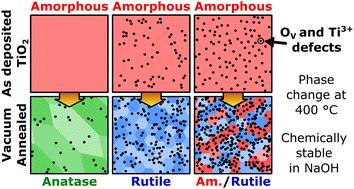Our official English website, www.x-mol.net, welcomes your
feedback! (Note: you will need to create a separate account there.)
Production of mixed phase Ti3+-rich TiO2 thin films by oxide defect engineered crystallization
Nanoscale ( IF 5.8 ) Pub Date : 2024-11-07 , DOI: 10.1039/d4nr03545c Lauri Palmolahti, Harri Ali-Löytty, Markku Hannula, Tuomas Tinus, Kalle Lehtola, Antti Tukiainen, Jarno Reuna, Mika Valden
Nanoscale ( IF 5.8 ) Pub Date : 2024-11-07 , DOI: 10.1039/d4nr03545c Lauri Palmolahti, Harri Ali-Löytty, Markku Hannula, Tuomas Tinus, Kalle Lehtola, Antti Tukiainen, Jarno Reuna, Mika Valden

|
Amorphous TiO2 has insufficient chemical stability that can be enhanced with annealing induced crystallization. However, the crystalline structure is already predetermined by the defect composition of the amorphous phase. In this paper, we demonstrate that the oxide defects, i.e., oxygen vacancies and Ti3+ states, can be created by O2 deficiency during ion-beam sputter deposition without affecting the O/Ti ratio of TiO2. The films are thus stoichiometric containing a variable degree of interstitial O instead of lattice O. Defect-free TiO2 crystallizes into microcrystalline anatase during vacuum annealing, whereas a moderate number density of defects causes crystallization into nanocrystalline rutile. An excessive number density of defects results in a mixed amorphous/nanocrystalline rutile phase that was analyzed by near-edge X-ray absorption fine structure (NEXAFS) spectroscopy. The number density of defects did not affect the crystallization temperature, which was 400 °C. All crystalline films, including the mixed amorphous/nanocrystalline rutile phase, were chemically stable in 1.0 M NaOH for 80 h. Unlike annealing treatments in oxidizing environments that are typically applied to improve stability, vacuum annealing improves the stability preserving also the Ti3+ gap states that are critical to the charge transfer in protective TiO2-based photoelectrode coatings.
中文翻译:

通过氧化物缺陷工程结晶生产富含 Ti3+ 的混合相 TiO2 薄膜
无定形 TiO2 的化学稳定性不足,可以通过退火诱导结晶来增强。然而,晶体结构已经由非晶相的缺陷组成预先决定。在本文中,我们证明了离子束溅射沉积过程中的 O2 缺乏可以产生氧化物缺陷,即氧空位和 Ti3+ 状态,而不会影响 TiO2 的 O/Ti 比率。因此,薄膜是化学计量的,包含不同程度的间隙 O 而不是晶格 O。无缺陷的 TiO2 在真空退火过程中结晶成微晶锐钛矿,而中等数量密度的缺陷导致结晶成纳米晶金红石。过高的缺陷数量密度会导致混合的非晶/纳米晶金红石相,通过近边缘 X 射线吸收精细结构 (NEXAFS) 光谱对其进行分析。缺陷的数量密度对结晶温度(400 °C)没有影响。 所有结晶膜,包括混合的无定形/纳米晶金红石相,在 1.0 M NaOH 中均在 80 h 内保持化学稳定性。与通常用于提高稳定性的氧化环境中的退火处理不同,真空退火提高了稳定性,同时保留了对保护性 TiO2 基光电电极涂层中的电荷转移至关重要的 Ti3+ 间隙状态。
更新日期:2024-11-07
中文翻译:

通过氧化物缺陷工程结晶生产富含 Ti3+ 的混合相 TiO2 薄膜
无定形 TiO2 的化学稳定性不足,可以通过退火诱导结晶来增强。然而,晶体结构已经由非晶相的缺陷组成预先决定。在本文中,我们证明了离子束溅射沉积过程中的 O2 缺乏可以产生氧化物缺陷,即氧空位和 Ti3+ 状态,而不会影响 TiO2 的 O/Ti 比率。因此,薄膜是化学计量的,包含不同程度的间隙 O 而不是晶格 O。无缺陷的 TiO2 在真空退火过程中结晶成微晶锐钛矿,而中等数量密度的缺陷导致结晶成纳米晶金红石。过高的缺陷数量密度会导致混合的非晶/纳米晶金红石相,通过近边缘 X 射线吸收精细结构 (NEXAFS) 光谱对其进行分析。缺陷的数量密度对结晶温度(400 °C)没有影响。 所有结晶膜,包括混合的无定形/纳米晶金红石相,在 1.0 M NaOH 中均在 80 h 内保持化学稳定性。与通常用于提高稳定性的氧化环境中的退火处理不同,真空退火提高了稳定性,同时保留了对保护性 TiO2 基光电电极涂层中的电荷转移至关重要的 Ti3+ 间隙状态。

































 京公网安备 11010802027423号
京公网安备 11010802027423号